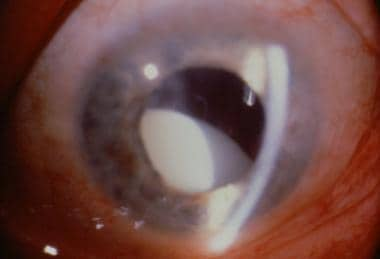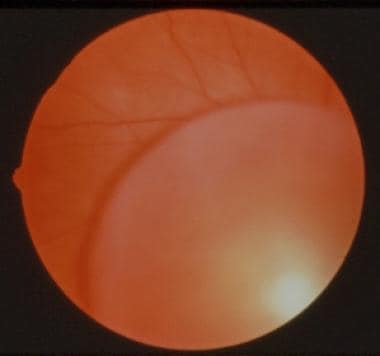Background
Ectopia lentis is defined as displacement or malposition of the crystalline lens of the eye. [1, 2, 3]
Berryat described the first reported case of lens dislocation in 1749, and Stellwag subsequently coined the term ectopia lentis in 1856 (describing a patient with congenital lens dislocation).
The lens is considered dislocated or luxated when it lies completely outside the lens patellar fossa, in the anterior chamber, free-floating in the vitreous, or directly on the retina. The lens is described as subluxed when it is partially displaced but contained within the lens space. In the absence of trauma, ectopia lentis should evoke suspicion for concomitant hereditary systemic disease or associated ocular disorders. [4, 5]
Pathophysiology
Disruption or dysfunction of the zonular fibers of the lens, regardless of cause (trauma or heritable condition), is the underlying pathophysiology of ectopia lentis. The degree of zonular impairment determines the degree of lens displacement.
Epidemiology
Frequency
United States
Ectopia lentis is a rare condition. Incidence in the general population is unknown. The most common cause of ectopia lentis is trauma, which accounts for nearly one half of all cases of lens dislocation.
Mortality/Morbidity
Ectopia lentis may cause marked visual disturbance, which varies with the degree of lens displacement and the underlying etiologic abnormality.
Sex
Males appear more prone to ocular trauma than females; therefore, a male preponderance has been reported. Male and female frequency varies with the etiology of the lens displacement.
Age
Ectopia lentis can occur at any age. [6] It may be present at birth, or it may manifest late in life.
Prognosis
Depending on the degree of lens dislocation, the age of onset, and its associated secondary complications, most patients do well.
Those patients who have trauma-associated ectopia lentis may have other more life-threatening complications (depending on the severity of the trauma).
Patients with heritable conditions associated with ectopia lentis may have other systemic complications.
Patient Education
Patients with ectopia lentis associated with a heritable condition need to be educated on the importance of following up with a primary care physician to rule out life-threatening disorders.
Safety glasses are advocated when risk of eye injury is possible.
-
Ectopia lentis. Dislocated traumatic lens (cataract).
-
Ectopia lentis. Dislocated lens into the vitreous secondary to trauma.
-
Ectopia lentis. Supertemporal dislocation of a lens in the right eye of a patient with Marfan syndrome. Note the attached zonular fibers.
-
Ectopia lentis. Microspherophakia and spontaneous inferior dislocation of a lens in a patient with Weil-Marchesani syndrome.









